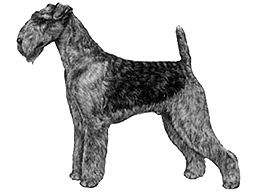Breed standards
Airedale Terrier
Breed standards are the official guidelines that describe the ideal characteristics, temperament, and appearance of a breed and ensures that the breed is fit for function with soundness essential.

Kennel Club, London 1994
FCI Standard No 7
Largest of the terriers, a muscular, active, fairly cobby dog, without suspicion of legginess or undue length of body.
Keen of expression, quick of movement, on the tip-toe of expectation at any movement. Character denoted and shown by expression of eyes, and by carriage of ears and erect tail.
Outgoing and confident, friendly, courageous and intelligent. Alert at all times, not aggressive but fearless.
Skull long and flat, not too broad between ears, and narrowing slightly to eyes. Well balanced, with no apparent difference in length between skull and foreface. Free from wrinkles, with stop hardly visible; cheeks level and free from fullness. Foreface well filled up before eyes, not dish-faced or falling away quickly below eyes, but a delicate chiselling prevents appearance of wedginess or plainness. Upper and lower jaws deep, powerful, strong and muscular, as strength of foreface is greatly desired. No excess development of the jaws to give a rounded or bulging appearance to the cheeks, as 'cheekiness' is undesirable. Lips tight, nose black.
Dark in colour, relatively small, not prominent, full of terrier expression, keenness and intelligence. Light or bold eye highly undesirable.
'V' shaped with a side carriage, small but not out of proportion to size of dog. Top line of folded ear slightly above level of skull. Pendulous ears or ears set too high undesirable.
Teeth strong. Jaws strong. Scissor bite, i.e. Upper teeth closely overlapping the lower teeth and set square to the jaws preferable, but vice-like bite acceptable. An overshot or undershot mouth undesirable.
Clean, muscular, of moderate length and thickness, gradually widening towards shoulders, and free from throatiness.
Shoulders long, well laid back, sloping obliquely, shoulder blades flat. Forelegs perfectly straight, with good bone. Elbows perpendicular to body, working free of sides.
Back short, strong, straight and level, showing no slackness. Loins muscular. Ribs well sprung. In short-coupled and well ribbed-up dogs there is little space between ribs and hips. When dog is long in couplings some slackness will be shown here. Chest deep (i.e. approximately level with elbows), but not broad.
Thighs long and powerful with muscular second thigh, stifles well bent, turned neither in nor out. Hocks well let down, parallel with each other when viewed from behind.
Small, round and compact, with a good depth of pad, well cushioned, and toes moderately arched, turning neither in nor out.
Previously customarily docked.
Docked: Set on high and carried gaily, not curled over back. Good strength and substance. Tip approximately at the same height as top of skull.
Undocked: Set on high and carried gaily. Good strength and substance.
Legs carried straight forward. Forelegs move freely, parallel to the sides. When approaching, forelegs should form a continuation of the straight line of the front, feet being same distance apart as elbows. Propulsive power is furnished by hind legs.
Hard, dense and wiry, not so long as to appear ragged. Lying straight and close, covering body and legs; outer coat hard, wiry and stiff, undercoat shorter and softer. Hardest coats are crinkling or just slightly waved; curly or soft coat highly undesirable.
Body-saddle black or grizzle as is top of the neck and top surface of tail. All other parts tan. Ears often a darker tan, and shading may occur round neck and side of skull. A few white hairs between forelegs acceptable.
Height: Dogs: approx. 58-61 cms (23-24 ins) from top of shoulder
Bitches approx. 56-59 cms (22-23 ins) from top of shoulder
Any departure from the foregoing points should be considered a fault and the seriousness with which the fault should be regarded should be in exact proportion to its degree and its effect upon the health and welfare of the dog.
Male animals should have two apparently normal testicles fully descended into the scrotum.



